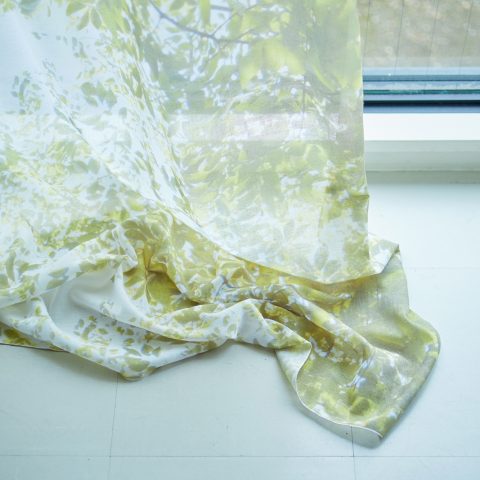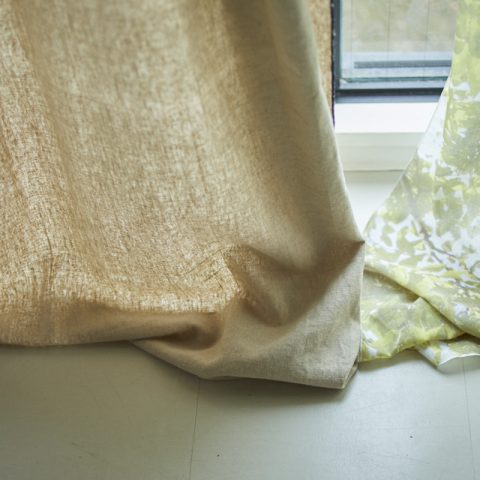Good manufacturing that designs life.

At one point, it’s a window that captures light.
At one point, it’s a table that makes your dining table stylish.
At one point, it’s a bed linen that gives you a good feel on your touch.
The expression of the cloth changes drastically depending on the place and purpose of use.
We will deliver a view of <14-23> from the lives of various people.
People who live in the city, people who live at the foot of the mountain, people who live by the sea Using cloth as a point of contact, we will come into contact with the lives of various people.
In the first installment, we will tell the story of why textile creator Namura dan reached <14-23>.

The family business is a fabric label that has been around since my grandfather’s generation. mother is a dyeing artist. Since he was a child, he has always had fabrics close to him. Namura dan, He became aware of fabrics as a job in 1999. Visit with father The world’s largest exhibition of interior textiles <Heim Textiles> was the trigger. The sight he saw in Europe for the first time was that It had a great impact on his later life.
“I was so impressed with the fever of wisdom. What is the interior I have seen in Japan? A completely different world was spreading in Europe. “ For the first time from there He turned his attention to his family business and used the graphics he learned to go to the interior. Beginning with hand-drawn illustrations, gradually to the expression of photographs on cloth he expanded the range of design.

One day, as a young designer, he has been attracting attention in the interior industry, and a turning point will come. He was selected as one of the trendsetters who set the trend for interiors at Heimtextile. It was the first feat for an Asian.
“I became involved in trends and became more familiar with European culture and life. For example, in Scandinavia, where they spend a long winter, they fill the room with spring cloth ahead of the season to pursue their dreams. Germany then, the curtains of most of the houses were left open as a cloth to decorate the windowsill without obstructing the view. While watching the life in Europe where the interior changes roughly depending on the season and mood, it is easier to use the cloth in Japan. The desire to have fun gradually became stronger.

Japanese residential architecture has grown in a blink of an eye after the war. With the advent of housing estates, curtains will be made in a standardized manner. After that, as lifestyles and architecture changed, curtains continued to be standardized until now. In the sophisticated furniture and space, only the scenery of the windows remains stopped in the Showa era.
I want to change not only the design but also the materials and usage to a more conscious form of life. The <14-23> series was born from such thoughts.
“In Japanese life, choosing a curtain is very difficult, isn’t it? The cycle of rebuilding a house is fast, and the size of the windows varies. If you move a lot, it will be thrown away every time, and if you live for a long time, it’s there for years. For those who have chosen something and have been hanging it for years, I think it would be nice to have a piece of cloth that can be roughly replaced depending on the mood without having to tailor it to the size of the window. I thought. ”

As the name suggests, the 140 cm x 230 cm square cloth can be easily decorated by simply clipping it with a clip. You can fold the top to adjust the length to your liking, so you can choose the size of the window. Easy to wash as it can be replaced roughly. Focusing on basic items, if you incorporate only one color or pattern, it will be an accent to your space. Just like changing clothes, you can color your life with cloth that suits the season and mood.
“In general, curtains are required to block light and line of sight and to insulate and retain heat in the space, but there should be room for designing other functions. For example, a transparent material that incorporates soft light. Or, the vivid colors give the space a three-dimensional effect. The comfort for me lies in the parts that cannot be expressed by numbers. ”
The size of <14-23>, which is easy to use other than windows, is useful in various places such as tablecloths, beds, sofa covers, and tapestries.
“Indians often use cloth as a tool, such as sari and turban. There must be a way to incorporate cloth into life as a tool in Japan. What I want to make is a” designed cloth tool. ” You can collect various ideas from all over the world little by little and mix them. My own theme is there. The result of collecting favorite things will be one’s life. I think that is the interior that is typical of Japan in the future.”

“Washing the cloth removes dust and prevents the deterioration of the fibers, so it will last a long time. Therefore, it is a major premise that the cloth you make can be washed. Even at home, the <14-23> that decorates the windowsill is suitable for the season. I always wash when I change it. ”
Trying the materials and how to use them at home, and commercialize only the ones that you are satisfied with. Through such repetition, I notice that the frequency of specifications at home is low for cloths that are too strong in texture and design. Originally there were more than 300 types of cloth, but we have narrowed down to those that are easy to use in our daily lives, and now there are about 30 types. All the products that fit in the 1/10 development are lined up on the shelves as “standard products”. The carefully selected <14-23> series naturally blends into any lifestyle because the creator himself is also the number one user.

“I’m not designing curtains, I’m creating fabrics that are easy to use,” says Namura dan. As the interest in manufacturing changed from design to the material itself, I focused on “recycled fabric”.
“The trend of the fabric industry has changed rapidly, and mass production and mass consumption have been repeated. Curtains with strict size regulations had a lot of parts to throw away. That was the bottleneck. By making it a reality, unnecessary parts have been significantly reduced, and it has become possible to manufacture products without waste. ”

“If you try to make a curtain normally, you will get extra fabric. Put it back in cotton and make it into thread and then make it into fabric. Until now, recycled fabric (thread) has always been made of different materials such as polyester and cotton. However, recently it has become possible to take out one material and recycle it. “Re.nen” is a cloth made in Spain, but it is a 100% recycled linen cloth. Compared to the crisp new linen fabric, it has a fluffy texture and is soft and has the ideal texture. ”
Recycled fabrics (threads) are still cheaper than new ones, and expensive linen can be easily incorporated. On the other hand, it also has disadvantages such as easy shrinkage and easy sunburn. Therefore, the recycled fabric (thread) is used for thick cloth that does not easily deteriorate, and has a soft texture that is comfortable to touch the skin. For a thin cloth, mix polyester and new linen, and use a taut fabric to take in light flexibly. At ieno textile, we propose fabrics that are familiar to our daily lives, using fabrics that make the most of each characteristic.

“The recycling technology itself isn’t really that new, it’s been around for 150 years in Japan. To recycle the military uniforms that were returned after Japan lost in World War II and clean up the rubble. The necessary ropes and gloves were made. That’s where the name of the “Gunte” (military glove) comes from. This fabric (thread) called “special spinning” made by recycling cotton was the first fabric (thread) that my grandfather used to start a fabric maker. It’s also a cloth. I heard that it was the cloth I had no choice but to choose at the time when resources were scarce. For me, it’s an ideal cloth that can be made in Japan without waste. ”

Born from lean materials, “14-23” shows various expressions depending on where you use it. It lightly teaches people who are reluctant to take in cloth the fun.
“For many people, I think that “how they are used in daily life” is more important and interesting than design and trends. I think that cloth is the point of contact for the cultures of various countries. If we accept it and adopt how to use it, I think we will find a Japanese way of life someday. I hope that with <14-23>, you will enjoy the encounter with the cloth that makes you think “feel good”.

